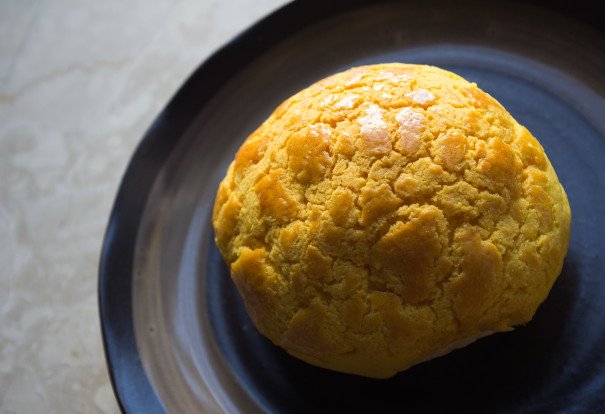
Sign Us Up for Pineapple Buns Sans Fruit But With a Layer of Lard

Sign Us Up for Pineapple Buns Sans Fruit But With a Layer of Lard
Bo lo baau in Hong Kong
The bun is ubiquitous, and takes on many roles: a quick breakfast, part of an indulgent dim sum feast, a tea time snack, dessert. The Cantonese call it bo lo baau, literally pineapple bun. In its authentic form, the bun is sans pineapples. It gets that name from its identifying feature—a golden, scored crust approximating the tropical fruit’s skin—exactly how pineapples got their name from pine cones, or grenades from pomegranates.
When baked properly, a pineapple bun is crunchy on top but soft and fluffy everywhere else, sort of like the Japanese melonpan or conchas from Mexico. No one is absolutely sure of the bun’s origins, but it seemed to have first appeared in Hong Kong in the 1960s. Bakers and food historians say Hongkongers weren’t satisfied with the bland white bread that was available, so someone decided to add a layer of lard, sugar, egg, and flour on top. The extra crisp and new flavor stuck.
Bo lo baau is so engrained in Hong Kong’s collective consciousness that, in 2005, when the public was asked to suggest new names for typhoons, Hong Kong’s favorite baked good became a strong contender. However, the city’s observatory decided to bump it off the list when a sober official realized reports of the city being ravaged by Tropical Storm Pineapple Bun would sound just a tad too absurd.
Most bakeries and teahouses in Hong Kong have their own take on bo lo baau. Some restaurants have folded it into their menus, too. The classic presentation, with a thick slab of butter wedged between halves, is easily the most popular. For a taste, head to any cha chaan teng, old school diners that are one of the city’s equalizers.
Other variations have ardent fans, too. The cheapest Michelin-starred restaurant in the world, Tim Ho Wan, serves triplets of “pineapple” roast pork buns that are part of nearly every order. Adzuki paste filling can lend a Japanese twist. Other places slice a classic bo lo baau in half and turn it into a sandwich, often with eggs and ham, or fish cakes. You can find croissants baked with the “pineapple” layer on top. Hip cafes dress it up further, plucking elements from other cuisines. And, surely, there are some with actual pineapple chunks in them. Bastardization is the name of the game.
But you can’t beat the original. School kids aching for a snack after school might grab one on their way home. White collar types nip out of the office a couple hours after lunch for some quick fuel: bo lo baau and strong milk tea. In Hong Kong, a fresh tray is never more than a block or two away. Just don’t forget the huge chunk of butter.